#juan antonio cortés
Text
DÍAS DE GUARDAR Domingo 8 de octubre de 2023
Marco Adame le hace la tarea a Diego Sinhue
La guerra sucia irrumpe en Morena
Villarreal, el lastre de la gobernadora Teresa Jiménez
Continue reading Untitled

View On WordPress
#Aguascalientes#Eduardo López Mares#Ernesto Prieto Ortega#Juan Carlos Alcántara#Libia Dennise García#Luis Alberto Villarreal#Marco Antonio Adame#Marko Cortés#Morena#PAN#Ricardo Sheffield#Rosario Corona#Sucesión 2024#Teresa Jiménez
0 notes
Text
i decided to unite my love for maps and for OT and make a map of the distribution of OT contestants from OT 2017 - 2023 in regards to their residence* because i find it so fascinating, like yeah it does kinda follow where major urban centers concentrate but also why is there so little people in valència? so many in iruña specifically? how is that outside madrid the only other OT contestant from castile is from guadalajara from all places???
*I followed the locations from the wikipedia page; in OT it's necessary to reside in spain but you don't need to have the spanish nationality to participate so i'll add the nationalities when needed!

below the cut i'll specify where each contestant is from, province by province, with pics of all the towns and cities !!!
A CORUÑA:
OT 2017: Pontedeume (Miriam Rodríguez), Santiago de Compostela (Roi Méndez)
OT 2018: As Pontes de García Rodríguez (Sabela Ramil)
OT 2020: Sada (Eva Barreiro)
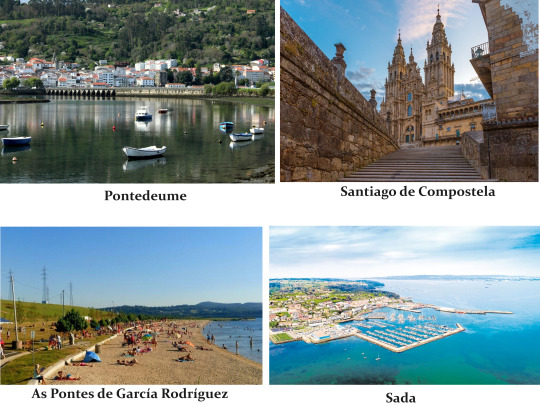
OURENSE:
OT 2017: Ourense (Luis Cepeda)

BIZKAIA:
OT 2017: Bilbo (Juan Antonio Cortés)
OT 2023: Getxo (Martin Urrutia)

NAFARROA:
OT 2017: Iruña (Amaia Romero)
OT 2018: Iruña (Natalia Lacunza)
OT 2020: Iruña (Anne Lukin, Maialen Gurbindo)
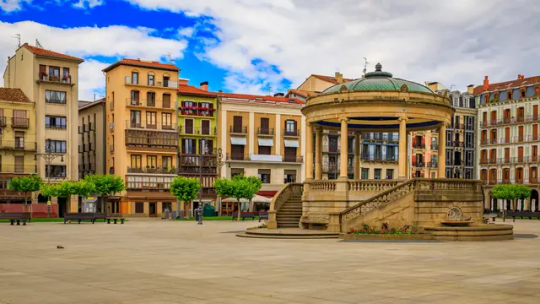
ZARAGOZA:
OT 2023: Zaragoza (Naiara Moreno), Magallón (Juanjo Bona)

TERUEL:
OT 2020: Alcañiz (Anaju Calavia)

BARCELONA:
OT 2017: Sant Climent de Llobregat (Aitana Ocaña), El Prat de Llobregat (Alfred García), Gavà (Nerea Rodríguez), Montgat (Raoul Vázquez), Terrassa (Miki Núñez)
OT 2018: Esplugues de Llobregat (Carlos Right)
OT 2020: Sant Cugat del Vallès (Nick Maylo), Sant Joan Despí (Ariadna Tortosa)
OT 2023: Vallirana (Lucas Curotto, he's Uruguayan)

ILLES BALEARS:
OT 2017: Palma (Ricky Merino)
OT 2018: Bunyola (Joan Garrido)
OT 2023: Ciutadella de Menorca (Chiara Oliver, she's half British)

GUADALAJARA:
OT 2023: Yunquera de Henares (Omar Samba, he's half Senegalese)
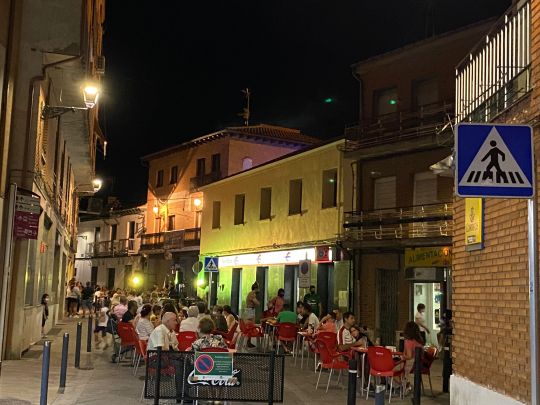
MADRID:
OT 2018: Madrid (María Villar, África Adalia, Alfonso La Cruz - he's Venezuelan)
OT 2020: Alcalá de Henares (Bruno Alves, he's Uruguayan)
OT 2023: San Fernando de Henares (Bea Fernández), Madrid (Ruslana Panchyshyna, she's Ukranian and has lived several years in the Canary Islands; in fact her accent is Canarian. I do not know which island / town and in the wikipedia page it listed her as a Madrid resident, that's why she's included here)

CÁCERES:
OT 2017: Malpartida de Plasencia (Thalía Garrido)
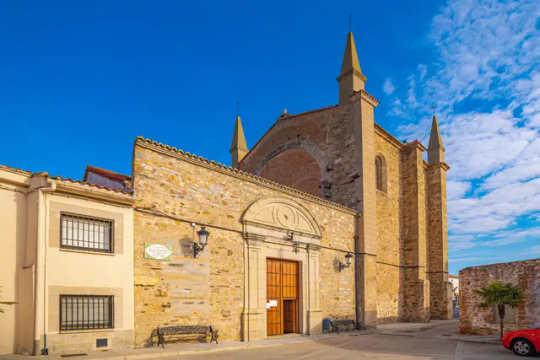
ALACANT:
OT 2018: Elx (Alba Reche)
OT 2020: Beniarrés (Samantha Gilabert)

MURCIA:
OT 2020: Murcia (Flavio Fernández)

GRANADA:
OT 2017: Huétor Tájar (Mimi Doblas)
OT 2023: Armilla (Paul Thin), Motril (Violeta Hódar), Ogíjares (Denna Ruiz)

MÁLAGA:
OT 2017: Alhaurín de la Torre (Mireya Bravo)
OT 2018: Torre del Mar (Marta Sango), Málaga (Noelia Franco)
OT 2023: Mijas (Salma Díaz)

CÓRDOBA:
OT 2020: Córdoba (Hugo Cobo), Adamuz (Rafa Romera)
OT 2023: Córdoba (Álex Márquez)
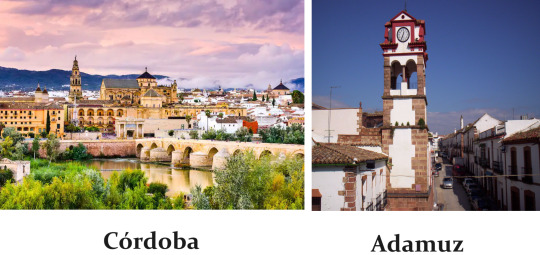
SEVILLA:
OT 2017: Dos Hermanas (Marina Rodríguez)
OT 2018: Bormujos (Famous Oberogo, he's Nigerian)
OT 2023: Sevilla (Álvaro Mayo)

CÁDIZ:
OT 2018: San Fernando (Julia Medina), Sanlúcar de Barrameda (Dave Zulueta)
OT 2020: Barbate (Jesús Rendón, Javy Ramírez)

CEUTA:
OT 2020: Ceuta (Gèrard Rodríguez)

LAS PALMAS:
OT 2018: Gáldar (Marilia Monzón)
OT 2020: Las Palmas de Gran Canaria (Eli Rosex, Nia Correia - she's half Cape Verdian)
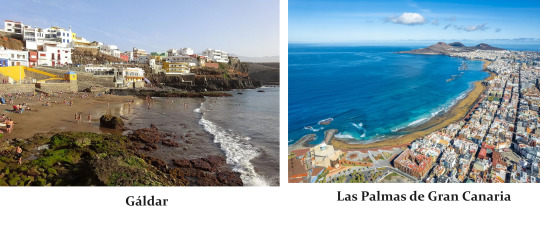
SANTA CRUZ DE TENERIFE:
OT 2017: San Cristóbal de La Laguna (Ana Guerra), Adeje (Agoney Hernández)
OT 2018: Adeje (Damion Frost, he's German)
OT 2023: San Cristóbal de La Laguna (Cris Bartolomé, he's half Equatorial Guinean), Santa Cruz de Tenerife (Suzete Correia, she's Sao Tomean)

#vivitalksot#spain#map#sorry for the mess in barcelona#i was trying to place the dots in more or less where the town was#but in the end it just looks bad. sorry :(
12 notes
·
View notes
Text
Don Felizardo de Rivera, Founder of Pila
Don Felizardo de Rivera y Evangelista (1755-1810) was the eldest of the three Rivera brothers, Don Felizardo, Don Miguel and Don Rafael. They were the owners of the estate Hacienda de Sta. Clara. They were the sons of Don Juan de Rivera, who had inherited the estate from the Spanish noble family, the Thenorios, and passed it on to his sons.
In the 18th century, due to flooding from its original location near the Laguna de Bay, the original town of Pila and its Church needed to be located to higher ground. So the Riveras planned to move it, just like their ancestor the Datu of Pila, Datu Maguinto, did in the 13th century.
However, a long, heated and controversial dispute rose between two prominent families at the time: The Riveras and the Relovas ("Pros" and "Antis". Don Regino Relova y San Antonio wanted the relocation on his land. Don Felizardo Rivera insisted that the town and church be moved to his hacienda in Sta. Clara.
Don Felizardo won after a long battle (starting October 14, 1794 and ending on July 13, 1803) after made an agreement with the parish priest: If the church was relocated to his estate, he pledged "the spiritual and material support of the Riveras to the church of St. Anthony in perpetuum up to the last of their line." The parish priest agreed.
Don Felizardo donated his lands to the church and to the municipal government but he also retained ownership of the lots surrounding what was to be the town plaza. He became the architect of the town's design, following Spanish colonial layout. He even built a kiln for manufacturing bricks and tiles for rebuilding the church, which was "transferred stone by stone" from its old location. The the ancestral houses were built around the plaza and the town municipio (municipal hall) was built opposite the church. With the assistance of the prominent families of Oca, Ruiz, and de Castro, he rebuilt the town of Pila ("Nuevo Pila") as it is to this day.
Don Felizardo served as gobernadorcillo in 1805, 1807, and 1809. He died on October 13, 1810 at the age of 55. He asked that "he be robed in the Franciscan habit upon his death and that a funeral mass be celebrated with him facing the altar of the newly-built church prior to his burial in the church crypt." His will (currently in the possession of the Rivera Family) was notarized by the town mayor at the time. At the time of his death, both pros and antis came to pay their respects and drop the long feud (the families later intermarried.) Don Felizardo's son Jose de Rivera later took over the gobernadorcillo post in 1811.
Don Felizardo de Rivera is the recognized founder of (Nuevo Pila) present-day Pila, Laguna, and the ancestor of the four main prominent families in Pila: Rivera, Relova, Agra and Alava.
WHEN A TOWN HAS TO MOVE: HOW PILA (LAGUNA) TRANSFERRED TO ITS PRESENT SITE (1794-1811)
Luciano P.R. Santiago
Philippine Quarterly of Culture and Society, Vol. 11, No. 2/3 (June/September 1983), pp. 93-106 (14 pages)
https://www.jstor.org/stable/29791789
--------------------------------------------------
During the 16th and 17th centuries, one of the earliest known leaders of Pila under Spanish Colonial Period was Don Antonio Maglilo (1696-1712), who governed Pila like his father Don Francisco Maglilo (1599), (Santiago, Ancient Pila, pg 11), the descendant of datu Maguinto.
In 1728, Don Maglilo’s descendant, Don Juan de Rivera, the founder of one of Pila’s most prominent families, the Rivera clan, became mayor of Pila. The Rivera’s were a “major branch of the Maglilo(s)” and changed their surname to “Rivera”, the “Taga-ilog”, or “People of the River”. (Santiago, Ancient Pila, pg 17).
Don Juan de Rivera married Doña Josepha Thenorio, who descended from Spanish nobility from Extremadura, Spain. The Thenorio family matriarch was Doña Maria Cortés de Monroy, the sister of Spanish Conquistador Hernán Cortés (1485-1547). (Santiago, Ancient Pila, pg 16). (Writer’s Note: Cortes had relations and a child with the Aztec princess Doña Isabel Moctezuma (born Tecuichpoch Ixcaxochitzin; 1509/1510 – 1550/1551), a daughter of the Aztec ruler Moctezuma II, and Cortes’s sister Doña Maria’s descendants married the descendants of a Philippine Pre-Hispanic king.)
Don Juan's descendant, Don Felizardo de Rivera (1755-1810), was at first a town executive from 1792 to 1793. He was governor of Pila in 1792. During the town move, he had drawn up grid plans (Cuadricula) in 1790 for the new site (where Pila was to be moved) based on the classical Spanish system of 'church-plaza-town hall complex' as originally prescribed by the 'Laws of the Indies (1573)' (laws issued by the Spanish Crown for town planning). He had become a self-taught architect. When the transfer was officially sanctioned (approved), he implemented his plans by serving as gobernadorcillo (governor) in 1805, 1807, and 1809 (he died in 1810). Because of his orderly design (of the town), Don Felizardo is considered the founder of 'Nuevo Pila (New Pila).' Don Felizardo retained all the residential lots around the rectangular plaza between the church and the town hall for the ancestral houses. The principal street is christened 'Rivera', which connects (the town) 'like a long umbilical cord' (back to) Pagalangan. (Santiago, Ancient Pila, pg 25). All the lots around the town plaza were given by Don Felizardo to his heirs, and the ancestral houses now stand on those lots.
Pila was moved again due to flooding from the lake, to Don Felizardo’s Hacienda in Santa Clara, Laguna. (Santiago, The Roots of Pila, Laguna, pgs 9, 10). On May 20, 1804, Pila Church was also moved to land at the hacienda. (Santiago, The Roots of Pila, Laguna, pgs 10, 11, 13) Today, the 200-plus year-old church is now called the San Antonio de Padua church, which was declared the National Shrine of San Antonio de Padua, contains a relic of the saint and is one of the oldest churches in the Philippines. The ruins of the original church are still standing at Pagalangan and have a historical marker as the site of the original church of Pila.
Don Felizardo is considered the founder of the present-day town of "Nueva Pila" ("New Pila") and the town’s designer and architect in the Spanish colonial grid style of city planning. (Santiago, The Roots of Pila, Laguna, pg 12). The Pila Municipal Hall was later built in June 1931, across from the Church, on land previously owned by Doña Corazon Rivera de Del Mundo, daughter of Don Luis Rivera. (Santiago, The Roots of Pila, Laguna, pg 20).
In his 1810 Last Will and Testament, Don Felizardo identifies himself as “Taong Tunai at Maguinoo” (a true maginoo). The document is with the Rivera family of Pila, Laguna.

#pilalaguna#pila laguna#pila laguna history#philippine history#pila laguna town#pila laguna museum#pila laguna church#pila laguna philippines#pila laguna ancestral houses#pila laguna heritage houses#Don Felizardo de Rivera#Don Juan de Rivera#Pila Laguna Founder#Pila Laguna Town Plaza
5 notes
·
View notes
Text
youtube
Domenico Cimarosa (1749-1801) : Der Kapellmeister / Il Maestro di Cappella
Bremer Barockorchester :
Sinfonia: 0:00 Rez: "Wenn ihr es mir gestattet": 2:48 Aria: "Dies der Passus der Violinen": 5:25 Rez: "Bravo! Bravissimo!": 13:00 Aria: "Lasset uns schwelgen": 15:12 Aria: "Ich bedanke mich": 20:41
Vocals: Jorge Alberto Martínez Violin: Stéphanie Paulet, Meelis Orgse, Javier Lupiáñez, Saaya Ikenoya, Antonio de Sarlo, Anna Stankiewicz, Camilo Cuellar Viola: Alice Vaz, Luis Miguel Pinzón Acosta Violoncello: Néstor Fabián Cortés Garzón, Azzurra Raneri Double Bass: Juan Díaz Traverso: Felipe Egaña, Isabelle Raphaelis Oboe: Olga Marulanda, Paulina Gómez Bassoon: Jeong-Guk Lee Horn: Gerard Serrano, Pepe Reche Guitar: Hugo Miguel de Rodas Sánchez Harpsichord: Nadine Remmert Timpani: Tobias Hamann
3 notes
·
View notes
Text
Indígenas en América y Europa
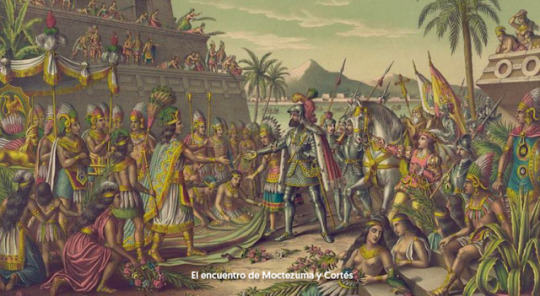
Por Juan J. Paz-y-Miño Cepeda
Fuentes: Rebelión
En 1992, con motivo de la conmemoración de los 500 años del “descubrimiento” de América por las grandes monarquías de Europa, se produjo un amplio y generalizado debate sobre los procesos de conquista y colonización en el continente. En aquellos momentos también se intentó “suavizar” conceptos y realidades, y se habló de “encuentro de dos mundos”. Pero existe una amplísima bibliografía que permite conocer y comprender el significado histórico de los acontecimientos del pasado.
Hace dos décadas se publicó en España una fabulosa colección de 53 obras de las “Crónicas de América”, en la cual autores como Cristóbal Colón, Hernán Cortés o Pedro de Cieza de León y tantos otros cronistas y relatores del siglo XVI, dan cuenta del proceso de conquista y describen la vida de los “indios” en todo el continente. Un libro extraordinario, El primer nueva corónica y buen gobierno de Guamán Poma de Ayala (del que más se conocen sus famosos dibujos), posiblemente fue escrito a inicios del siglo XVII, pero el manuscrito fue descubierto en 1909 y recién publicado en 1936. Esta obra transformó los conocimientos sobre el imperio de los Incas. Imposible dejar de nombrar a fray Bartolomé de las Casas y sus dos obras fundamentales: Brevísima relación de la destrucción de las indias y la Historia de las Indias, de mediados del siglo XVI, que describen las atrocidades de la conquista y la colonización sobre los indios.
Saltando distancias, hay una pléyade de investigadores sobre el mundo indígena de la época de la conquista. Nathan Wachtel, en Los vencidos. Los indios del Perú frente a la conquista española (1530-1570) destacó cómo la cultura de los Incas, tan diferente a la de los “blancos” conquistadores, fue determinante en su propia derrota. El mexicano Miguel León Portilla, en Visión de los Vencidos. Relaciones Indígenas de la Conquista, puso en claro lo que ocurrió en el pueblo Azteca. En la gran lista de estudiosos, al menos citaré a John V. Murra o a Waldemar Espinoza Soriano en sus trabajos sobre los Incas, o a Alberto Ruz Lhuillier sobre los Mayas y a Josefina Oliva de Coll en La resistencia indígena ante la conquista. Jorge Juan y Antonio de Ulloa dejaron, en sus Noticias secretas de América (1735), una detallada relación sobre las realidades del coloniaje en lo que hoy constituyen las repúblicas de Venezuela, Colombia, Ecuador y Perú. Pero también cabría nombrar a Jacques Lafaye, quien en Los conquistadores, trazó la visión que, en el otro extremo, tuvo el conjunto de aquellos aventureros al llegar a tierras indígenas, en las que creían no solo cumplir una misión divina sino reeditar el proceso de la Reconquista contra los “moros” en España.
Existe, por tanto, contundente bibliografía histórica para entender, sin lugar a duda ni titubeos, que la conquista fue un proceso sangriento de sometimiento y destrucción sobre las poblaciones indígenas de América. Y para comprender, además, que para América Latina el coloniaje marcó las bases del “proceso de acumulación primitiva de capitales”, estudiado por K. Marx en El Capital, y que fuera tan beneficioso para Europa, así como también marcó el subdesarrollo de la región, del cual aún no se logra desprender.
En una nueva era de redefinición de las relaciones internacionales como la que vivimos en el presente y en la cual ha comenzado el quiebre histórico de la hegemonía de Estados Unidos/Europa, nuevamente se acude a revisar la historia para ofrecer otros enfoques que salven la situación tradicional. De la mano de académicos y políticos identificados con las derechas, tanto en España (y Portugal) como entre los autodenominados “hispanistas” de América Latina, han aparecido posiciones y estudios que identifican a los conquistadores como “libertadores” de pueblos, porque a ellos se unieron sectores de las noblezas Aztecas o Incas y miles de indígenas que tenían múltiples razones para levantarse contra las capas dominantes internas. Pero también reivindican una “comunidad hispánica”, bajo la idea de que nunca existió coloniaje, pues estas tierras americanas eran provincias de la Madre Patria, que ejerció una acción benéfica (https://rb.gy/vm6sh). Tratan de negar procesos que no fueron “leyenda negra” sino realidades demostradas desde los escritos del siglo XVI.
En otro reciente estudio, destacado por agencias internacionales de prensa, acogido como novedad atrayente para la renovación histórica y titulado El descubrimiento de Europa. Indígenas y mestizos en el Viejo Mundo (https://rb.gy/p6nfk), Esteban Mira Caballos pormenoriza, con lujo de fuentes, cómo fue la llegada de los primeros indígenas a España (llevados inicialmente como esclavos); sigue, además, las huellas de antiguos nobles indígenas que lograron trasladarse a España, y estudia las migraciones indígenas (también de mestizos), que crearon espacios propios de vida y acción. Sin duda, apunta a resaltar los aportes socioculturales que los indígenas lograron introducir en tierras tan lejanas y que los propios europeos no suelen creer y menos admitir.
Entre sus varias obras, Mira Caballos tiene un libro anterior: Conquista y destrucción de las Indias, 1492-1573, en el cual reconoce la naturaleza brutal y destructora de la conquista. Pero, a propósito de su reciente libro, este historiador no ha dejado de añadir cierta inclinación “europeizante” y llega a afirmar que la conquista, en definitiva, no fue tal, sino un proceso en el que el 95% de los “conquistadores” eran indígenas (https://rb.gy/gh3al); señala las alianzas de muchos nobles con los españoles, así como observa antiguos curacas/caciques convertidos en dominadores de sus propios pueblos. A propósito de estas afirmaciones, claro que es conocida la alianza que trabaron poblaciones indígenas enteras para apoyar a los blancos conquistadores y para tratar de obtener ventajas de ello. Pero eso no les convierte en “conquistadores” que tuvieran en mente la conquista de esencia colonialista que portaban los blancos españoles/europeos al servir de instrumentos de la avanzada mercantilista, en plena era capitalista.
De modo que las nuevas formas europeizantes de concebir la conquista y el coloniaje tratan de minimizar el carácter brutal y destructor que tuvo el proceso de conquista en América Latina y buscan encontrar una comunidad internacional entre iguales, cuando lo cierto es que desde la época colonial hasta el presente, es una realidad incontrastable la diferenciación marcada entre el norte dominante y el sur global dependiente y dominado por potencias capitalistas centrales, que aprovecharon del antiguo colonialismo para forjar su propia vía de desarrollo, del que fueron apartados los países latinoamericanos.
Historia y Presente – blog
www.historiaypresente.com
7 notes
·
View notes
Text



Reading List - Lista para Leer
Aves sin nido Clorinda Matto de Turner
Dom Casmurro Joaquim Maria Machado de Assis
Ariel José Enrique Rodó
El Moto Joaquin Garcia Monge
La amada inmóvil Amado Nervo
Desolación Gabriela Mistral
La señorita Etcétera Arqueles Vela
La vorágine José Eustasio Rivera
Doña Bárbara Rómulo Gallegos
Cuentos de Amor, de Locura y de Muerte Horacio Quiroga
Other selected works
Isabel Allende, “Dos palabras”
Anónimo, “Romance de la pérdida de Alhama”
Anónimo, Lazarillo de Tormes (Prólogo; Tratados 1, 2, 3, 7)
Gustavo Adolfo Bécquer, Rima LIII (“Volverán las oscuras golondrinas”)
Jorge Luis Borges, “Borges y yo”
Jorge Luis Borges, “El Sur”
Julia de Burgos, “A Julia de Burgos”
Miguel de Cervantes, Don Quijote (Primera parte, capítulos 1–5, 8 y 9; Segunda parte, capítulo 74)
Julio Cortázar, “La noche boca arriba”
Hernán Cortés, “Segunda carta de relación” (selecciones)
Sor Juana Inés de la Cruz, “Hombres necios que acusáis”
Rubén Darío, “A Roosevelt”
Don Juan Manuel, Conde Lucanor, Exemplo XXXV (“De lo que aconteció a un mozo que casó con una mujer muy fuerte y muy brava”)
Osvaldo Dragún, El hombre que se convirtió en perro
Carlos Fuentes, “Chac Mool”
Federico García Lorca, La casa de Bernarda Alba
Federico García Lorca, “Prendimiento de Antoñito el Camborio en el camino de Sevilla”
Gabriel García Márquez, “El ahogado más hermoso del mundo”
Gabriel García Márquez, “La siesta del martes”
Garcilaso de la Vega, Soneto XXIII (“En tanto que de rosa y azucena”)
Luis de Góngora, Soneto CLXVI (“Mientras por competir con tu cabello”)
Nicolás Guillén, “Balada de los dos abuelos”
José María Heredia, “En una tempestad”
Miguel León-Portilla, Visión de los vencidos (dos secciones: “Los presagios, según los informantes de Sahagún” y “Se ha perdido el pueblo mexica”)
Antonio Machado, “He andado muchos caminos”
José Martí, “Nuestra América”
Rosa Montero, “Como la vida misma”
Nancy Morejón, “Mujer negra”
Pablo Neruda, “Walking around”
Emilia Pardo Bazán, “Las medias rojas”
Francisco de Quevedo, Salmo XVII (“Miré los muros de la patria mía”)
Horacio Quiroga, “El hijo”
Tomás Rivera, . . . y no se lo tragó la tierra (dos capítulos: “... y no se lo tragó la tierra” y “La noche buena”)
Juan Rulfo, “No oyes ladrar los perros”
Alfonsina Storni, “Peso ancestral”
Tirso de Molina, El burlador de Sevilla y convidado de piedra
Sabine Ulibarrí, “Mi caballo mago”
Miguel de Unamuno, San Manuel Bueno, mártir

#lista para leer#catholic#feminine#reading list#Spanish reading list#spanish#reading#books to read#classic books
3 notes
·
View notes
Text
@asongofstarkandtargaryen There's a couple of comics and films I wanted to post something about them some time ago, so here they are
Black is Beltza is a duology of comics, the first one was published in 2014 and the second in 2022, and they have been adapted into two Basque animated films recently in 2018 and 2022, Black is Beltza and Black is Beltza II: Ainhoa.
One of the main things of the comics are the sociopolitical environment of the places and the period the films are set in, for example the first one is set in the 60's mainly in New York and the sequel is set in the 80's and among other places, in Pamplona.
Black is Beltza (2018)

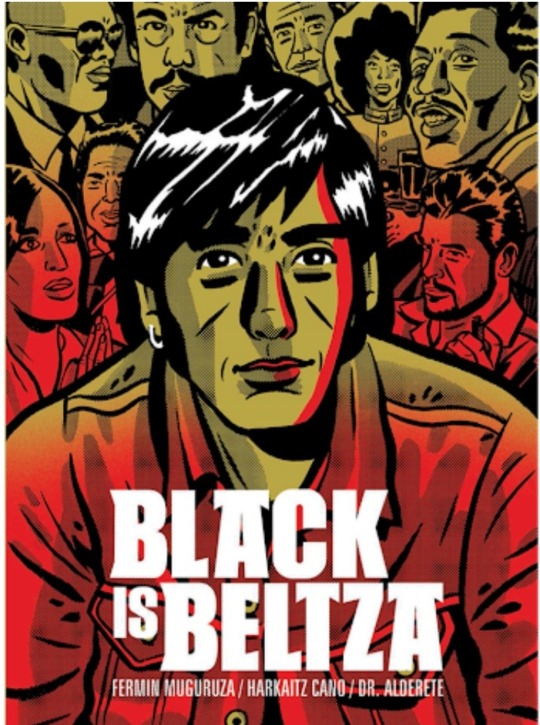

youtube
October 1965. The Pamplona troupe of giants, a typical image of the San Fermín festivities, is invited to parade on Fifth Avenue in New York. But not everyone will be able to leave: due to racial discrimination, the North American authorities prohibit the participation of the two black giants. Based on this real event, "Black is Beltza" tells the story of Manex, the waiter in charge of carrying one of the giants. Headed for a long and unexpected journey, Manex will witness key events in history: the racial riots resulting from the assassination of Malcolm X, the eccentricities of the characters in The Factory, the alliance between the Cuban secret services and the Black Panthers, and the proto-hippie psychedelia of early music festivals.
Duration: 87 min.
Script: Harkaitz Cano, Fermín Muguruza, Eduard Solà (Comic: Fermín Muguruza, Harkaitz Cano, Jorge Alderete)
Animation Companies: ETB, Setmàgic Audiovisual, Talka Records & Films
Cast
Unax Ugalde: Manex
Isaach de Bankolé: Wilson Clever
Iseo: Amanda Tamaya
Sergi López: Warren Philips
Ramón Agirre: Xebero
Jorge Perugorria: Sargento Bravo
Angelo Moore: Rudy
María de Medeiros: Amira
Emma Suárez: Laia
Oscar Jaenada: Che Guevara
Rossy de Palma: Ruth Abransom
Ramón Barea: Ramiro
Hamid Krim: Yassim
Guillermo Toledo: Teniente Muñoz
Ander Lipus: guardia civil
Josean Bengoetxea: Juanpe, Pancho Villa
Lenval Brown: Jimmy
Valeria Maldonado: Esperanza
Sergio Arau: Juan Rulfo
Jorge Ferrera: Eliseo
Giancarlo Ruiz: Tin-Tan, Smithy, Sergei Titov
Josh Kun: Dwayne
Ray Fernández: Cte. Antonovich
Victor Navarrete: Guerrillero 1
Iban Rusiñol: Laurent
Exprai: Pedro del Taller, Hernán Cortés
Márgenes Dermer: azafata
Ramón Zumitrenko: Sf dentista
Stuart Casson: Otis Redding, Emory Douglas
KO the Knockout: Ben Cauley
Sistaeyeire: Angela Davis
Dratzo Gomex: policía fronteriza I
Marieder Iriart: Iman
Mariam Bachir: Amal
Black is Beltza II: Ainhoa (2022)


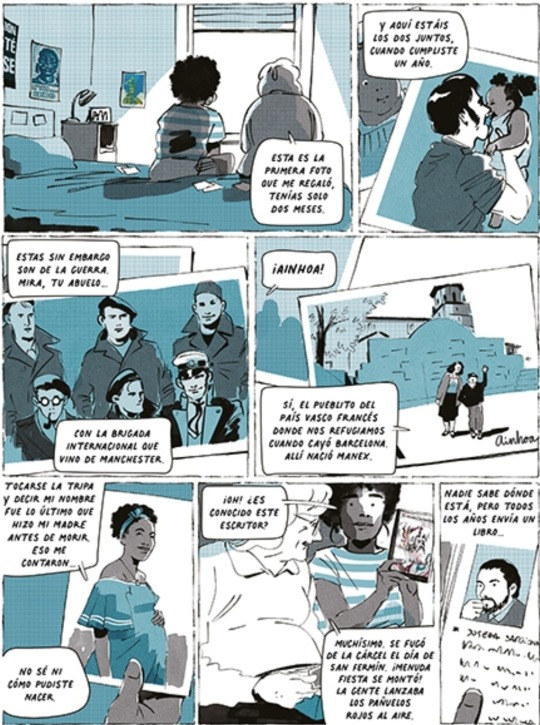
youtube
Ainhoa was born by a miracle in La Paz (Bolivia) after the death, in a parapolice attack, of her mother Amanda. She grew up in Cuba and in 1988, at the age of 21, she traveled to the Basque Country to see the land of his father Manex. In the middle of the repressive conflict, she meets Josune, a committed journalist, and her gang of friends. When one of them dies of a heroin overdose, Ainhoa and Josune set out on an initiation journey that will take them through Lebanon, Afghanistan and the city of Marseille. These are the last years of the Cold War and both will delve into the dark world of drug trafficking networks and their close ties to political plots.
Direction: Fermin Muguruza
Duration: 86 min.
Script: Fermín Muguruza, Isa Campo, Harkaitz Cano (Comic: Fermín Muguruza)
Music: Maite Arrotajauregi
Photography: Animation, Mariona Omedes
Companies: Co-production Spain-Argentina; Talka Records & Films
Cast
Maria Cruickshank: Ainhoa
Itziar Ituño: Josune
Manex Fuchs: Hamid
Antonio de la Torre: Rafael
Darko Peric: Igor
Ariadna Gil: Isabelle
Eneko Sagardoy: Diego
Mikel Losada: Mikel
Ramón Agirre: Xebero
Miren Gaztañaga: Amatxi Tere
Maite Larburu Iman
Ximun Fuchs: Jean-Pierre
Gorka Otxoa: Iñigo Kortatu
Fermín Muguruza: Fermin Kortatu
Jon Plazaola: Javier Salutregi
Peio Berteretxe: Didier
Maryse Urruty: Armineh
Isidro: Isidro
Joseba Sarrionandia: Martin
Maria Forni: Yady
Iban Rusiñol: Commisaire Marcel
Natalia Abu-sharar: off Sabra y Shatila
Moraysys Silva: Tania
Maykel García Cardo: Felix The Cat
Bruno Coscia: Arthur
Maria Amolategui: Amaia Apaolaza
Papet-J: Chef Chérif
4 notes
·
View notes
Text
Mi Año en Lecturas (Terminadas y Recomendadas) [En Orden Alfabético]
Adiós a Todo Eso – Ernest Hemingway (Novela)
Agripina: Primera Emperatriz de Roma – Emma Southon (Investigación Histórica)
Alejandro Magno y las Águilas de Roma – Javier Negrete (Novela Ficción Histórica)
Aquitania – Eva García Sáenz de Ururti (Novela Ficción Histórica)
Biografía de la Inhumanidad –José Antonio Marina (Investigación)
Breve Historia del Mundo – Ernst H. Gombrich (Historia)
Breves Respuestas a las Grandes Preguntas – Stephen Hawking (Divulgación)
Caos: El Poder de los Idiotas – Juan Luis Cebrián (Investigación)
Clicks Contra la Humanidad: Libertad y Resistencia en la Era de la Distracción Tecnológica – James Williams (Investigación)
Desmorir: Una Reflexión sobre la Enfermedad en un Mundo Capitalista – Anne Boyer (Investigación)
Dignos de Ser Humanos – Rutger Bregman (Investigación)
El Cura Hidalgo y sus Amigos – Paco Ignacio Taibo II (Investigación Histórica)
El Extraño Caso de Benjamín Button – F. Scott Fitzgerald (Cuento)
El Hombre Ilustrado – Ray Bradbury (Cuentos)
El Llano en Llamas – Juan Rulfo (Novela Costumbrista)
El País de los Ciegos – H. G. Wells (Cuento)
El Poder de las Historias: O Cómo han Cautivado al Ser Humano, desde La Ilíada hasta Harry Potter – Martin Puchner (Investigación)
El Precio era Alto – F. Scott Fitzgerald (Cuentos)
Expiación – Ian McEwan (Novela)
Fahrenheit 451– Ray Bradbury (Novela)
Filosofía a Martillazos – Darío Sztajnszrajber (Filosofía)
Guía del Autoestopista Galáctico – Douglas Adams (Novela)
Humanos: Una Historia de Cómo la Hemos Pifiado – Tom Phillips (Investigación Histórica)
Identidad: La Demanda de Dignidad y Las Políticas de Resentimiento – Francis Fukuyama (Investigación)
La Invasión de América – Antonio Espino (Historia)
La Noche en que Frankenstein Leyó El Quijote – Santiago Posteguillo (Divulgación)
La Odisea – Homero (Epopeya)
La Ridícula Idea de No Volver a Verte – Rosa Montero (Memoirs/Investigación)
La Ruta Prohibida y Otros Enigmas de la Historia – Javier Sierra (Investigación)
Las Caras Ocultas de Hernán Cortés – Alejandro Rosas (Investigación Histórica)
Las Epidemias Políticas – Peter Sloterdijk (Investigación)
Locos por los Clásicos: Todo lo que Debes Saber sobre los Autores Griegos y Latinos – Emilio del Río (Divulgación)
Meditaciones – Marco Aurelio Antonino (Filosofía)
México Bizarro – Alejandro Rosas & Julio Patán (Relatos)
Mundo Orwell: Manual de Supervivencia para un Mundo Hiperconectado – Ángel Gómez de Ágrieda (Investigación)
París era una Fiesta – Ernest Hemingway (Memoirs)
Pequeño Elogio de la Fuga del Mundo – Rémy Oudghiri (Relatos)
Reflexiones – Aristóteles (Filosofía)
Sobre el Anarquismo – Noam Chomsky (Filosofía)
SPQR: Una Historia de la Antigua Roma – Mary Beard (Investigación Histórica)
Suave es La Noche – F. Scott Fitzgerald (Novela)
Un Mundo Feliz – Aldous Huxley (Novela)
Un Paraíso en el Infierno – Rebecca Solnit (Investigación)
Un Verdor Terrible – Benjamín Labatut (Relatos)
Una Historia Diferente del Mundo – Fernando Trías de Bes (Investigación)
Una Princesa de Marte – Edgar Rice Burroughs (Novela)
4 notes
·
View notes
Video
vimeo
Apple Arcade - A New World To Play In from Mauro Chiarello on Vimeo.
Director: Ian Pons Jewell
Producer: Chris Avery @ Apple
Writer: Jordan Pories
Creative Director: Hamish Pinnel
Art Director: Esteban Cardona
Group Creative Directors: Sam Oliver & Carl Broadhurst
AD Producer: Jacob Stitzel
Production Company: Reset
Managing Director: Dave Morrison
Executive Producers: Deannie O'Neil & Jen Beitler
Head of Production: JP Colombo
Producer: Megan Moore
Director of Photography: Mauro Chiarello
Director’s Assistant: George Daniell
Casting: Majo Gallardo
Costume Designer: Nayeli de Alba
Production Service Company: The Lift
Producer: Fuad Abded
Managing Director: Avelino Rodriguez
Production Manger: Israel González Cadena
Unit Manager: Vladimir Espinoza
Production Coordinator: Liliana Huacuja
APOC: David Carretero
Script: Andrea Eduardina
Key PA: Juan Tovar
Production Assistants: Erick Ávila, Miguel Luna, Isaac Alvarez
Runner: Paulina Camacho
Chaperone: Paulina Marín
Chaperone: Paulina Maqueda
Locations Manager: Sergio Aguilar
Locations Assistants: Itzia Rojas, Rodrigo López, Eduardo Gutierrez, Andrés Macías, Juan Chávez
1st AD DGA: Robert Phillips
1st AD: Sandra Mayerstein
2nd AD Vala Cárdenas
2nd AD: Lorenza Ramos
1st AC Horacio Vega
2nd AC: Adonay Meza
Camera PA: Edson Reyes
DIT: Julio Cesar Gonzalez
Data Manager: Hayde Medina Corona
VTR Operator: Jonathan Fernando Noriega Hernández
VTR Assistants: Eduardo Martinez & Miguel Valdez
Wheels Operator: Felipe Pérez-Burchard
Steadicam Operator: Gerardo Manjarezz
Trinity Operator: Niels Lindelien
Gaffer: Leonardo Julián
Key Grip: Juan Antonio Aguilar López
Key Grip: Jose Marcos Vilchis
VFX Supervisor: Daniel "Chovy" Cordero
VFX Assistants: Rafael Santana Cruz & Francisco Ruben Perez Reyes
Production Designers: Robin Brown & Margarita Laborde
Hair & Make Up: Chela Olea
Hair & Make Up Assistants: Yoali Cortés, Ixchel Cortés
Stunt Coordinator: Tomas Guzman
Art Coordinator: Katia Duarte
Propmaster: Diego Téllez
Decorator: Melinda Ridaura
Decorator: Sandra Jalife
Art Assistant: Jessica Peralta
Wardrobe Coordinator: Giselle Arriaga
Wardrobe Assistants: Rodrigo Montoya, Paulina Regalado, Christian Fernando, Rocelia Alexandra
Graphic Design: Mireya Guerrero
Renders: Hugo Jiménez
Swings: Daniel Hernández, Jesús Enriquez, Aldo Márquez, Juan Cisneros, Néstor Luna, Luis Hernández, Gabriel Cabrera.
Edit Company: Whitehouse Post, Los Angeles
Editor: Tobias Suhm
Executive Producer: Joanna Manning
Post Producer: Jordan Stricklin
VFX Company: Framestore
VFX Supervisor: James Rogers
Senior Producer: Joe Greenberg
Art Director: Carlos Vidal
Lead Data Wrangler: Fabio Zapata
Data Wrangler: Juan Colon
Coordinator: Evan Kanter
CAST
Kid in car: Ariella Covalin-Mizarahi
Metro Guy: Shu Sakimoto
Chef & Waiters:
Jack Morris
Jean Wolf
Allison Vargas
Taco Stand:
Mariana Arias
Emme Gonzalez
Paulina Camacho
Oscar Sagrado
Raphael De Cecco
Ivan Modragon
Christian Godoy
Miguel Angel
Airplane: Heidy Diaz
Popcorn Eaters:
Micah Bijon
Charlie Scovill
Clothes Guy: Rick Darge
Bus Shelter: Yuki Oc-Noda
0 notes
Text
Instala el Frente Amplio por México su comité organizador

El dirigente del PAN, Marko Cortés, subrayó que es un proceso inédito que permite involucrar a la sociedad para elegir a una persona que cambie el rumbo en 2024
Los dirigentes nacionales de los partidos Acción Nacional (PAN), Marko Cortes, Revolucionario Institucional (PRI), Alejandro Moreno y de la Revolución Democrática (PRD), Jesús Zambrano, al lado de representantes de asociaciones ciudadanas, instalaron hoy el Comité Organizador del Frente Amplio por México.
Destacaron que los integrantes del Comité son Patricia Mccarthy Caballero, Arturo Sánchez Gutiérrez, Marco Antonio Baños, Alejandra Latapí, Rodrigo Morales Manzanares, María Teresa González Luna y Juan Manuel Herrero.
De ellos, los dirigentes partidistas coincidieron en señalar su reconocida trayectoria profesional, responsabilidad, prestigio y honorabilidad, ya que han destacado en los ámbitos de la academia, la investigación, el activismo y los organismos autónomos.
El dirigente del PAN, Marko Cortés, dijo que los integrantes del Comité Organizador son hombres y mujeres que han dado un paso adelante con su experiencia electoral, para que la sociedad y los partidos políticos corrijan el rumbo de México. "Es un proceso inédito, que permite involucrar a la sociedad para elegir a una persona que cambie el rumbo en 2024", apuntó.
Indicó que los representantes de Acción Nacional en el Comité Organizador son Armando Tejeda Cid y Raymundo Bolaños, Secretario de Elecciones del CEN y Coordinador General Jurídico de esa misma dirigencia, respectivamente.
Alejandro Moreno, presidente nacional del PRI, subrayó que el Frente Amplio por México “avanza con pasos firmes” en la elección de quien será responsable de su construcción. Asimismo, hizo énfasis en que “la figura de frente político está prevista en la ley y ha sido diseñada para respetar y hacer valer las leyes electorales”.
Informó que los representantes del PRI en el Comité Organizador son el diputado federal Rubén Moreira y el Secretario de Acción Electoral del Comité Ejecutivo Nacional, Rolando Zapata.
“Ahora, hay muchos que son émulos de Walter Mercado, en paz descanse y que ahora dicen que tienen bola de cristal. No midieron los tiempos, ellos creían que no podíamos construir una gran fuerza y una gran potencia en un frente amplio.
“Ya lo hicimos, no saben qué hacer, en estos días vean cómo se jalan del pelo, se atacan, se borran las bardas unos a los otros, violando la ley y yo no veo cómo van a administrar 270 días este proceso que tuvieron al anunciarlo antes”, declaró.
Negó que Claudio X. González sea quien mande en la alianza opositora, pues aseguró que el método se diseñó con la participación de más de 500 organizaciones de la sociedad civil.
Aseguró que mientras las ‘corcholatas’ cada día están más divididas, la oposición se consolida con un proceso en el que se cumplirá la ley y se seleccionará bien a la o el responsable de la construcción del Frente Amplio por México.
Alejandro Moreno destacó que a diferencia de lo que ocurre en Morena, en el frente opositor se está haciendo un esfuerzo inédito y habrá confrontación de ideas, foros, participación directa, consulta, votación en urnas y no se impondrá nada, porque van a decidir los ciudadanos.
Read the full article
0 notes
Text
El Comité Ejecutivo del PP de la Provincia de Badajoz aprueba la lista de diputados provinciales
El Comité Ejecutivo Provincial del PP de Badajoz, que preside Manuel Naharro, ha aprobado esta tarde, por unanimidad, la lista de diputados provinciales que formarán el Grupo Popular en la Diputación de Badajoz la legislatura que ahora arranca, y del que Juan Antonio Barrios continuará siendo portavoz.
NOMBRE DIPUTADO/DA
PARTIDO JUDICIAL
LOCALIDAD Y CARGO
Gema Cortés Luna
Badajoz
Badajoz…

View On WordPress
0 notes
Text
IMSS e Insabi supervisan con Evelyn Salgado trabajos de transformación de salud en Guerrero

ACAPULCO * 15 de marzo de 2023.
) Gobierno de Guerrero
La gobernadora Evelyn Salgado Pineda recibió en Guerrero al director general del IMSS,

Zoé Robledo Aburto, junto con el director general del Instituto de Salud para el Bienestar (Insabi), Juan Antonio Ferrer Aguilar, para revisar los avances en los trabajos para mejorar y transformar el sistema de salud en Guerrero.
En esta reunión interinstitucional celebrada en Casa Guerrero, se dio seguimiento a los avances en el abasto de medicamentos, obras de infraestructura hospitalaria, así como equipamiento médico y la federalización de los servicios de salud en Guerrero.
"No hay nada más importante que la salud y la vida, es un área a la que le hemos dedicado todo nuestro empeño y dedicación y llevamos un buen avance en la transformación del sistema de salud en Guerrero para ofrecer un servicio de excelencia y acceso a la salud en

las zonas más alejadas", puntualizó la gobernadora quien también reconoció el trabajo en equipo entre las instituciones de salud federales con Guerrero.
En la mesa de trabajo el director general del IMSS, Zoé Robledo Aburto, informó que a Guerrero llegarán 69 médicos especialistas de base y 349 residentes de último año, además de equipo médico y obras de infraestructura para fortalecer el sistema de salud prioritariamente a la población sin seguridad social como uno de los compromisos del presidente Andrés Manuel López Obrador con la entidad.
Evelyn Salgado reconoció el trabajo desarrollado para mejorar el acceso a la salud de las instituciones como el IMSS-Bienestar y el Insabi, así como la Secretaría de Salud Federal en coordinación con la Secretaría de Salud Guerrero, prioritariamente en zonas alejadas como las regiones de La Montaña y La Sierra donde mayor necesidad se tiene.
La mandataria estatal, puntualizó se realiza un trabajo a fondo en los servicios de salud en Guerrero donde, "no solo hacía falta una manita de gato, sino un zarpazo de tigre a todo el sistema de salud, y que hoy se está haciendo, la misma gente lo está reconociendo, incluso la gente de las comunidades allá en la sierra, en la montaña, en Costa Chica, con medicamentos y médicos atendiendo".
A la reunión asistieron la secretaria de Salud Guerrero, Aidé Ibarez Castro; Marcos Cantero Cortés, secretario del Consejo de Salubridad General y representante del secretario de Salud, Jorge Alcocer Varela; el enlace IMSS-Bienestar Guerrero, Víctor Hugo Borja Aburto; el titular de la Unidad del Programa IMSS-Bienestar, Manuel Cervantes Ocampo; el gerente de proyectos de Desarrollo, Víctor Manuel Tapia Castañeda y Josefina Estrada Martínez, titular de la Oficina de Representación del IMSS en la entidad, entre otros.
) Síguenos en nuestra página Facebook @acapulcopress.news
Read the full article
#AidéIbarezCastro#EvelynSalgadoPineda#IMSS#InstitutodeSaludparaelBienestar(Insabi)#JuanAntonioFerrerAguilar#SecretaríadeSaludGuerrero(SSG)#ZoéRobledoAburto
0 notes
Video
vimeo
Apple Arcade - A New World To Play In from Ian Pons Jewell on Vimeo.
Director: Ian Pons Jewell
Producer: Chris Avery @ Apple
Writer: Jordan Pories
Creative Director: Hamish Pinnel
Art Director: Esteban Cardona
Group Creative Directors: Sam Oliver & Carl Broadhurst
AD Producer: Jacob Stitzel
Production Company: Reset
Managing Director: Dave Morrison
Executive Producers: Deannie O'Neil & Jen Beitler
Head of Production: JP Colombo
Producer: Megan Moore
Director of Photography: Mauro Chiarello
Director’s Assistant: George Daniell
Casting: Majo Gallardo
Costume Designer: Nayeli de Alba
Production Service Company: The Lift
Producer: Fuad Abded
Managing Director: Avelino Rodriguez
Production Manger: Israel González Cadena
Unit Manager: Vladimir Espinoza
Production Coordinator: Liliana Huacuja
APOC: David Carretero
Script: Andrea Eduardina
Key PA: Juan Tovar
Production Assistants: Erick Ávila, Miguel Luna, Isaac Alvarez
Runner: Paulina Camacho
Chaperone: Paulina Marín
Chaperone: Paulina Maqueda
Locations Manager: Sergio Aguilar
Locations Assistants: Itzia Rojas, Rodrigo López, Eduardo Gutierrez, Andrés Macías, Juan Chávez
1st AD DGA: Robert Phillips
1st AD: Sandra Mayerstein
2nd AD Vala Cárdenas
2nd AD: Lorenza Ramos
1st AC Horacio Vega
2nd AC: Adonay Meza
Camera PA: Edson Reyes
DIT: Julio Cesar Gonzalez
Data Manager: Hayde Medina Corona
VTR Operator: Jonathan Fernando Noriega Hernández
VTR Assistants: Eduardo Martinez & Miguel Valdez
Wheels Operator: Felipe Pérez-Burchard
Steadicam Operator: Gerardo Manjarezz
Trinity Operator: Niels Lindelien
Gaffer: Leonardo Julián
Key Grip: Juan Antonio Aguilar López
Key Grip: Jose Marcos Vilchis
VFX Supervisor: Daniel "Chovy" Cordero
VFX Assistants: Rafael Santana Cruz & Francisco Ruben Perez Reyes
Production Designers: Robin Brown & Margarita Laborde
Hair & Make Up: Chela Olea
Hair & Make Up Assistants: Yoali Cortés, Ixchel Cortés
Stunt Coordinator: Tomas Guzman
Art Coordinator: Katia Duarte
Propmaster: Diego Téllez
Decorator: Melinda Ridaura
Decorator: Sandra Jalife
Art Assistant: Jessica Peralta
Wardrobe Coordinator: Giselle Arriaga
Wardrobe Assistants: Rodrigo Montoya, Paulina Regalado, Christian Fernando, Rocelia Alexandra
Graphic Design: Mireya Guerrero
Renders: Hugo Jiménez
Swings: Daniel Hernández, Jesús Enriquez, Aldo Márquez, Juan Cisneros, Néstor Luna, Luis Hernández, Gabriel Cabrera.
Edit Company: Whitehouse Post, Los Angeles
Editor: Tobias Suhm
Executive Producer: Joanna Manning
Post Producer: Jordan Stricklin
VFX Company: Framestore
VFX Supervisor: James Rogers
Senior Producer: Joe Greenberg
Art Director: Carlos Vidal
Lead Data Wrangler: Fabio Zapata
Data Wrangler: Juan Colon
Coordinator: Evan Kanter
CAST
Kid in car: Ariella Covalin-Mizarahi
Metro Guy: Shu Sakimoto
Chef & Waiters:
Jack Morris
Jean Wolf
Allison Vargas
Taco Stand:
Mariana Arias
Emme Gonzalez
Paulina Camacho
Oscar Sagrado
Raphael De Cecco
Ivan Modragon
Christian Godoy
Miguel Angel
Airplane: Heidy Diaz
Popcorn Eaters:
Micah Bijon
Charlie Scovill
Clothes Guy: Rick Darge
Bus Shelter: Yuki Oc-Noda
0 notes
Text
Blog Post #4
Just like American History, Meixco has a history on how they became the country they are today. There is a timeline according to “Archive.org”. I am a firm believer that if you are going to visit a country, or live in a new country, then you need to know the history. Just like when Hispanics are moving to American for one reason or another, in order to become a U.S. citizen, you need to know the history and critical event that formed America into what it is today and what we stand for. With that being said, here are some crucial events that happened in Mexico, to further explain their upcoming:
“1519 — Hernán Cortés arrives in Mexico. In 1521 Cortés and Indian allies conquer Tenochtitlán, the Aztec capital.
1531 — Juan Diego, one of the first Christianized Aztecs, reports the appearance of the Virgin of Guadalupe.
1551 — National university is founded in Mexico City.
1808 — Napoleon dethrones the Spanish king, stimulating political unrest throughout Spain’s empire.
1810–c. 1821 — During wars of independence that pit Mexicans against one another as well as the forces of Spain, over 12 percent of Mexican population dies. Mexican independence is achieved under the 1821 Plan of Iguala, which promises equality for citizens and preserves the privileges of the Catholic Church.
1821 — Moses Austin receives land grant to settle Anglo-Americans in Texas.
1824 — Constitution of 1824 establishes Mexico as a republic with a federal system.
1825 — Joel R. Poinsett is named the first United States minister to Mexico. At the first Pan-American congress in 1826, Mexico’s representative defeats Poinsett’s plans for a hemisphere-wide trade pact, interpreting it as a cover for United States dominance.
1835 — Rebels seeking independence for Texas fight the Mexican army at the Alamo. In 1836 the Texas Republic becomes independent.
1837–1841 — Revolts favoring federalism over the centralizing constitution imposed by Antonio López de Santa Anna in 1836 occur in much of Mexico.
1845 — The United States annexes Texas.
1846–1848 — Mexico and the United States are at war. In the resulting treaty of Guadalupe-Hidalgo, Mexico cedes Texas, New Mexico, and California to the United States.
1854 — United States Senate approves Gadsden Purchase from Mexico, adding nearly 30,000 square miles to southern Arizona and New Mexico.
1854–1861 — Benito Juárez and other liberals overthrow Santa Anna (Revolution of Ayutla). The liberal reforms they inaugurate encourage division of Indian and church lands into private holdings, subject clergy and military to regular courts, and establish religious freedom.
1857 — Constitution establishes a federal republic and, moving beyond the Constitution of 1824, guarantees the individual rights of free speech, assembly, and press. In 1858–1861 supporters and opponents of the reforms fight the War of the Reform, which ends in liberal victory.
1862–1867 — The French emperor Napoleon III, in alliance with conservative and proclerical Mexicans, installs Maximilian of Habsburg as emperor of Mexico. On May 5, 1862, Mexican troops defeat Napoleon III’s troops at Puebla. (The holiday Cinco de Mayo honors this victory.) In 1867 Juárez’s forces defeat and execute Maximilian.
1876–1911 — The Porfiriato, the authoritarian regime of the longtime president Porfirio Díaz, maintains the liberal economic policies and secularization achieved under Juárez and encourages foreign investment.
1884 — United States–Mexican railroad connection links El Paso and Mexico City.
1891 — United States Immigration Act authorizes inspection stations at ports of entry on the Mexican and Canadian borders.
1904 — To curtail undocumented entry of Asian and European immigrants into the United States through Mexico, immigration inspectors on horseback begin to patrol the United States–Mexican border.
1910–1917 — Spurred by discontent with the dictatorial Díaz regime, regional animosities, and increasing economic inequality in the countryside, guerrilla armies fight the Mexican Revolution, temporarily breaking the country into warring regions.
1914 — United States forces occupy the port city of Veracruz for seven months.
1916 — United States President Woodrow Wilson orders Gen. John Pershing to capture guerrilla leader Pancho Villa after Villa’s attack on Columbus, New Mexico. For nine months 4,000 American troops search in vain for Villa.
1917 — The Constitution of 1917 maintains republican and liberal features of the 1824 and 1857 constitutions but also guarantees social rights such as a living wage. It nationalizes mineral resources and prohibits foreign businessmen from appealing to their home governments to protect their property. Altered many times, this constitution remains in force.
1917 — The United States Immigration Act applies a literacy test and head tax to Mexicans entering the United States legally, spurring undocumented immigration by Mexican workers. (During the World War I labor shortage, these provisions are temporarily suspended.)
1918 — Oil is declared an inalienable national resource, and existing titles to oil lands become concessions. The United States government protests.
1924 — The Immigration Act of 1924 establishes the United States Border Patrol.
1927 — Conflict over the 1917 Constitution’s provisions for separation of church and state leads to nationalization of church property and armed rebellion, which the government suppresses.
1929 — President Plutarco Elías Calles founds the predecessor to the Partido Revolucionario Institucional (PRI). The PRI controls the national government throughout the next seven decades.
1929–1934 — Nearly 500,000 Mexican nationals and some Mexican Americans are repatriated to Mexico, forcibly or voluntarily, during the Great Depression.
1933 — President Franklin D. Roosevelt announces the Good Neighbor Policy, promising to end United States military intervention in Latin American countries.
1933–1934 — Mexican painter Diego Rivera, a Marxist, completes murals for the RCA building in Rockefeller Center, New York City. When he refuses to replace the face of Lenin with that of an anonymous individual, as requested by Nelson Rockefeller, the murals are destroyed.
1937–1938 — Mexico nationalizes British and United States railroad and oil industries. A 1947 settlement provides compensation to foreign investors.
1940s — El Congreso de Pueblos que Hablan Español (congress of Spanish-speaking peoples) calls for the relaxation of United States restrictions on immigration, naturalization, and citizenship.
1942 — The United States and Mexico adopt the Emergency Farm Labor Program, or bracero program, allowing Mexicans to perform contract work in the United States for a fixed period. Over the next 22 years of the program’s existence, more than 4.6 million labor contracts are issued.
1957 — Citizens of El Paso, Texas, elect the first Mexican American mayor of a US city.
1968 — Riot police repress student protests for democratization of the government, killing over 100 civilians in the massacre of Tlatelolco in Mexico City.
1970–1976 — Mexican President Luis Echeverría visits Cuba and the Soviet Union and engineers a partial lifting of the hemispheric embargo against Cuba.
1973 — United States creates the Drug Enforcement Administration (DEA) to suppress domestic and foreign production of narcotics intended for sale in the United States.
1982 — President José Lopez Portillo visits Nicaragua and praises the Sandinista revolution.
1986 — The Immigration Reform and Control Act (IRCA), or Simpson-Rodino Act, increases funds for the United States Border Patrol, penalizes employers for hiring unauthorized workers, and provides amnesty to long-term undocumented residents.
1986 — The Anti–Drug Abuse Act enhances the DEA’s power to extradite foreign drug traffickers and prosecute them in the United States.
1990 — The Mexican Secretariat of Foreign Affairs creates the Program for Mexican Communities Abroad to aid Mexicans in adapting to life in the United States and to foster continuing ties to the homeland.
1994 — The North American Free Trade Agreement (NAFTA) begins to phase out tariffs between the United States, Canada, and Mexico over fifteen years.
1994 — Zapatista rebellion in Chiapas, Mexico, protests the PRI’s dominance of political power and the government’s indifference to the fate of peasants and indigenous peoples.
1994 — California voters adopt Proposition 187, denying undocumented residents access to nearly all public services in the state. (Courts later strike down much of the law as unconstitutional.)
1995 — Over 500,000 Mexicans work in maquiladoras, factories on the border that assemble parts from the United States and export the finished goods back to the United States.”
I have attached with a link an animated video that doing a brief explanation on the history of Mexico. It goes into detail about what could have happened if certain things did not go they way they had planned, and things they wish could have happened. It is a great short film that is about 30 minutes long that I encourage you to watch.
youtube
Work Cited
maps and timeline. (2022). Retrieved 26 September 2022, from http://archive.oah.org/special-issues/mexico/timeline.html
(2022). Retrieved 26 September 2022, from https://www.youtube.com/watch?v=Q4kF0lRzGnI
0 notes
Photo

Triste noticia. Falleció Juan Monedita, compositor y músico que formó parte de la alineación original de Los Patita de Perro, es reconocido por su gran trabajo musical dedicado a las niñas y niños. Ramon A Go Go @ramon_agogo escribió: Alguna vez en el Vive Latino platicaba con @miamigoelpino (@losestramboticos) de @juanmonedita y los Monedita de Oro, coincidimos en que era sin duda el mejor compositor de música para niñ@s de habla hispana. Fue inspiración para crear @yucatanagogobanda; cuando estaba en @lospatitadeperro se quedaban en la casa cuando venían a tocar a la ciudad. Por su amistad quise hacer una banda de rock para niñ@s, hoy con dolor escribo que lo voy a extrañar siempre. Fue un gran amigo, un gran padre, un gran músico, un gran compositor. Si no lo han hecho, escuchen la música de Monedita de Oro, la mejor banda de rock para niños y niñas!!! Te vamos a extrañar Juan!!! Te queremos Maestro Juan Monedita!!” @nachopataofficial publicó en la página de Patita de Perro: “Esta fue la última vez que tocamos juntos, el año pasado en el museo Erasto Cortés en Puebla. ¿Quién se iba a imaginar? Me acabo de enterar hace rato camino a la CDMX. 😢 La tristeza es proporcional al cariño que te tengo. Gracias por todo Juan. Tu amigo por siempre. Nacho”. El músico estuvo delicado ultimamente. El pasado 11 de agosto fue hospitalizado, en sus redes se daba a conocer su estado de salud, esperábamos que se recuperara satisfactoriamente, pero no fue así. En paz descanse Juan Monedita (Juan Antonio Morales Herrera). https://www.instagram.com/p/CiOq_vnO9xd/?igshid=NGJjMDIxMWI=
0 notes
Text
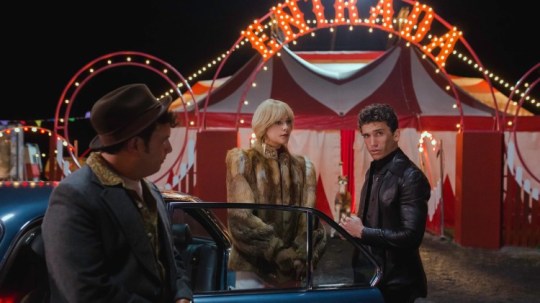
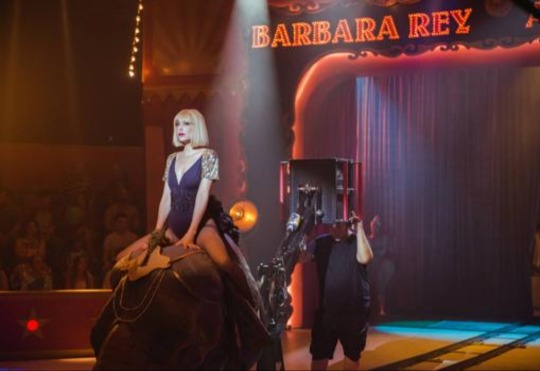

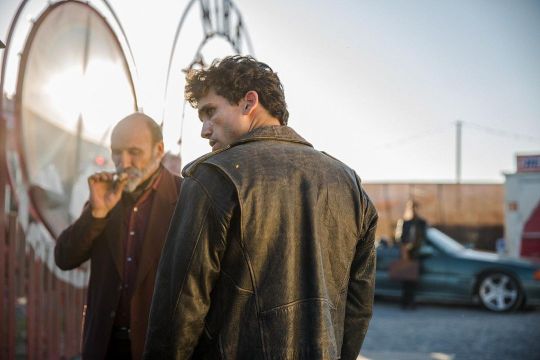


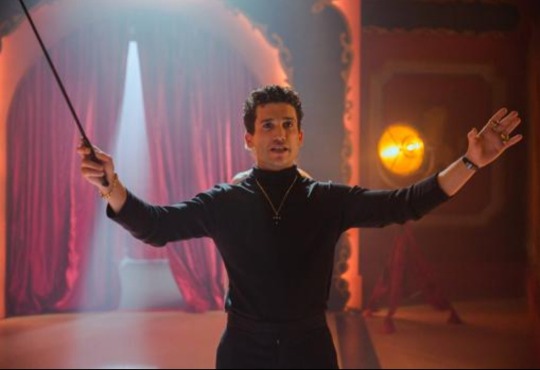

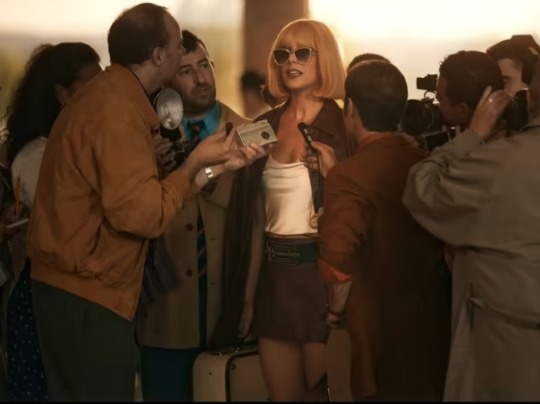
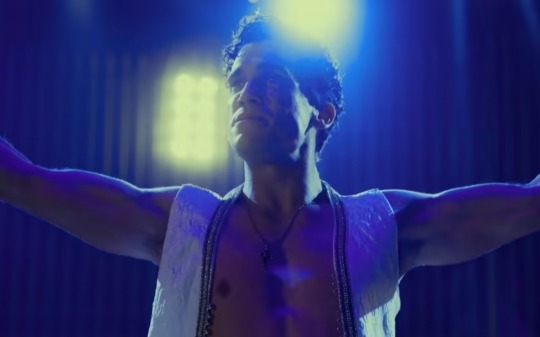
Cristo y Rey (2022)
@asongofstarkandtargaryen there's a new upcoming series with Belén Cuesta and Jaime Lorente, and they play the leading couple, Bárbara Rey and Ángel Cristo.
Synopsis
Madrid, 1979. Ángel Cristo is the most famous circus tamer of the county. Bárbara Rey, actress and muse of uncovering, the most desired woman in Spain. From the time they meet until they announce their marriage, only a few weeks pass. It is the wedding of the year and the news covers the covers of all the magazines. The Circus of Bárbara Rey and Ángel Cristo becomes the fashion show; a million dollar business money, fame, luxury…
Nine years of relationship in which Spain witnessed the happiness of the couple: the birth of Angelito and Sofía, the purchase of sports cars, jewelry, an ostentatious villa in La Moraleja… Far from the flashes, however, there is an escalation of drug addiction, gambling, infidelity and abuse...
And, in the background, the shadow of Barbara's relationship with Juan Carlos I (she was the king's lover between 1976 and 1994)
Cast
Belén Cuesta as Bárbara Rey (Totana, Murcia, 2th February 1950-), artistic name of María García García, daughter of Andrés García Valenzuela and Salvadora García Molina. She firstly started her career as a dancer, but then she became an actress, vedette & tv presenter on theatres, cinema and tv shows, and during her marriage with Ángel Cristo she became an elephant tamer.
Jaime Lorente as Ángel Cristo (Huelva, Andalucía, 17th October 1944- Alcorcón, Madrid, 4th May 2010), artistic name of Ángel Papadopoulos Dordid, son of Christoforo Papadopoulos Stanovich a Greek of Romani descent trapeze artist and the Spanish contortionist Margarita Dordid. They were a family of famous circus performers. Christoforo's brother, Miro who owned the Circus Florida, married also a woman from Málaga called Canela Remedios Vaquero and has 8 children together, some of them became very famous, like their eldest daughter, María del Pino Papadopoulos Vázquez known as "Miss Mara" who became an internationally famous trapeze artist and some of her brothers formed a group of phonanbulists called "Tonitos".
Ángel he received the Gold Medal of the International Circus Festival in 1982 and founded his own circus, the Russian Circus.
Adriana Torrebejano as Chelo García Cortés, a queer journalist and tv presenter who had a brief love affair with Bárbara Rey in the 80's. Chelo was in a relationship with the tv journalist José Manuel Parada Rodríguez during those years but it's said that she came out of the closet because of Bárbara and then she ended up broking up with her partner.
Artur Busquets as Francisco Javier García-Ontiveros "Payasito" (Little Clown), Ángel's best friend and a member of the Russian Circus.
Chema Adeva as Christoforo "Cristo" Papadopoulos Stanovich
Belén Ponce de León as Margarita Dordid "the little Carolina"
Vicente Vergará as Andrés García Valenzuela
Diana Peñalver as Salvadora García Molina
José Milan as Blasco
Cristóbal Suárez as Juan Carlos I
Salomé Jiménez as Queen Sofía
Secun de la Rosa as Richardi
David Lorente as Paco Ostos
Ana Carrasco as Hortensia
Mirela Balic as Cata
Antonio Buil as Mancuso
Elvira Cuadrupani as Patri Veracruz
Jesús Castro as bullfighter Francisco Rivera "Paquirri"
Julián Teurlais as Doctor 1
Data sheet
Creator/Showrunner: Daniel Écija
Executive production: Montse García and Daniel Écija
Script coordinator: Andrés Martín Soto and Patricia Trueba
Screenplay: Daniel Écija, Andrés Martín Soto, Patricia Trueba, César Mendizábal, Iñaki San Román, Ángel Gasco-Coloma
Direction: David Molina and Manu Gómez
Production Direction: Salvador Gómez
Casting direction: Ana Sainz-Trápaga and Patricia Álvarez de Miranda
Director of Photography: Tommie Ferreras
AEC, 2nd unit: Ismael Issa
Art Direction: Koldo Valles
Costume Design: Loles Garcia
Makeup and costume design: Romana González 'Pato' and Antonio Panizza
Music: Daniel Sánchez De La Hera
Sound: Néstor Luz
Editor: Fernando Márquez
Special Effects (VFX): Jordi San Agustín and Álvaro Vicario
#series#period dramas#belén cuesta#jaime lorente#bárbara rey#ángel cristo#biopics#cristo y rey 2022#upcoming series#secun de la rosa#artur busquets#adriana torrebajano#david lorente#elvira cuadrupani#chema adeva#salomé jiménez#ana carrasco#josé milan#antonio buil#mirela balic#belén ponce de león#vicente vergará#diana peñalver#jesús castro#julián teurlais
5 notes
·
View notes